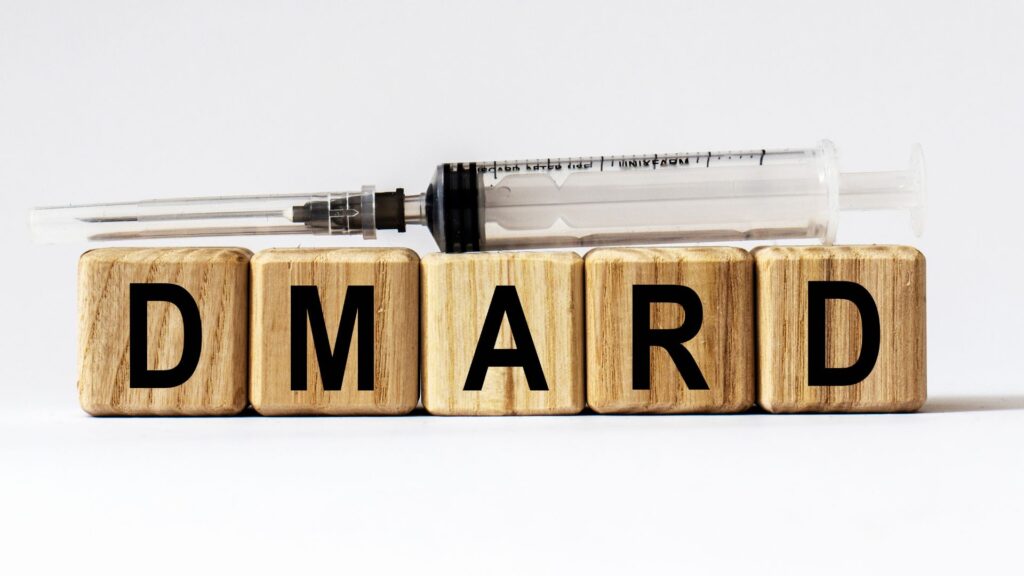Many people with rheumatoid arthritis search for ways to manage their condition. They want relief from pain and to stop the disease from damaging their joints more. A key part of treatment involves DMARDs, or Disease-Modifying Antirheumatic Drugs.
These drugs are known for slowing down joint damage.
One important fact about these medications is that methotrexate, a type of DMARD, has been very effective in treating severe cases of rheumatoid arthritis. It helps save joints from further damage.
This blog post will guide you through what DMARDs are, how they work, and other treatments that can help. We will also talk about managing side effects and making lifestyle changes while on these medications.
Keep reading to discover how to optimize your treatment with DMARDs.
Key Takeaways
- DMARDs slow down the progression of rheumatoid arthritis and prevent joint damage. Methotrexate is one example that doctors often prescribe.
- There are different types of DMARDs, including conventional synthetic, biologic, and targeted synthetic ones. Each works differently to control the disease.
- Side effects like nausea and liver issues may occur with DMARD use. Regular checks with a healthcare provider are important for managing these side effects.
- Lifestyle changes such as a healthy diet and regular exercise can enhance the effectiveness of DMARD treatment in rheumatoid arthritis management.
- Combining DMARDs with supplements like borage seed oil might offer additional benefits against joint inflammation but always consult a healthcare provider first.
Understanding DMARDs

Understanding DMARDs lays the foundation for effectively managing rheumatoid arthritis. These drugs significantly reduce inflammation and prevent joint damage, offering hope to many facing this chronic condition.
Types of DMARDs
DMARDs act as a foundation in controlling rheumatoid arthritis by stopping the progression of joint damage and inflammation. The variety and mechanisms of these drugs present personalized ways to manage the condition effectively.
- Conventional synthetic DMARDs (csDMARDs) consist of medications such as Methotrexate, Leflunomide, Sulfasalazine, and Hydroxychloroquine. Doctors often commence with these because they can impede disease progression and prevent joint and tissue damage over time.
- Biologic DMARDs aim at particular parts of the immune system that participate in the inflammation process of rheumatoid arthritis. Examples include TNF inhibitors, IL-6 inhibitors, and B-cell depletion therapy which incorporates drugs like Infliximab and Rituximab.
- Targeted synthetic DMARDs (tsDMARDs), such as JAK inhibitors, halt pathways in the body’s immune response that results in inflammation, offering another option for those who may not benefit from biologics or csDMARDS.
Each type of DMARD operates differently, assisting healthcare providers to adapt treatment based on individual patient requirements and disease seriousness. In the following, we’ll examine vital DMARDs used in treating rheumatoid arthritis more closely.
How DMARDs Work
Transitioning between the various types of DMARDs, it’s crucial to comprehend the mechanism of these medications in addressing rheumatoid arthritis. Doctors typically prescribe DMARDs due to their ability to focus on the root causes of inflammation in joints.
These medications perform by obstructing specific routes in your immune system that provoke inflammation and joint damage. Consequently, this action diminishes swelling and pain and has the potential to slow or avert further damage to your joints.
DMARDs are fundamental in slowing down progression and barring permanent damage in rheumatoid arthritis.
Taking methotrexate as an instance, this medicine disrupts a particular enzyme entangled in the rapid multiplication of cells, a prevalent event in inflammatory conditions like rheumatoid arthritis.
Consequently, methotrexate is exceedingly efficient at managing symptoms and preserving joint utility over time. This method highlights the importance of timely intervention with DMARD therapy in modifying the disease’s trajectory and enhancing the patient’s lifestyle.
Key DMARDs in Rheumatoid Arthritis Treatment
Effective treatment for rheumatoid arthritis often involves disease-modifying antirheumatic drugs (DMARDs). These medications play a critical role in managing symptoms and slowing the progression of the disease.
Methotrexate
Doctors often prescribe Methotrexate for patients with severe rheumatoid arthritis. This DMARD has shown significant improvements by saving joints from damage. Patients take it once a week, either as a pill or through an injection.
It works by slowing down the inflammation in the joints.
Understanding how Methotrexate acts is key to managing rheumatoid arthritis effectively. It stops the body’s immune system from attacking its own tissues, reducing pain and swelling in the affected areas.
This makes it a cornerstone in the treatment of inflammatory arthritis, providing relief and preserving joint function over time.
Leflunomide
Leflunomide stands out as a key DMARD for treating rheumatoid arthritis. It targets the disease’s progression directly, aiming to slow down joint damage and reduce inflammation that causes pain and swelling in patients.
Unlike some medications that only mask symptoms, leflunomide works at the cellular level to prevent further joint degradation.
Leflunomide marks a significant step forward in managing rheumatoid arthritis effectively.
This medication offers hope for those who have not found relief with other treatments, making it an essential part of comprehensive care plans for rheumatoid arthritis. Its role in preserving joint function and preventing severe damage underscores its importance in treatment strategies.
Sulfasalazine
Sulfasalazine stands out as a conventional DMARD doctors often use for rheumatoid arthritis treatment. It works by slowing down the progression of the disease. This helps to prevent joint damage and reduces inflammation, which are common problems in patients with this condition.
Doctors have seen good results from using sulfasalazine, especially when combined with other medications.
This drug is part of a broader strategy to manage rheumatoid arthritis effectively. Patients take it orally, and it can make a big difference in their quality of life by reducing pain and improving joint function.
For many people dealing with rheumatoid arthritis, sulfasalazine offers hope and a way to keep the disease under control.
Biologic DMARDs and Their Role
Biologic DMARDs target specific parts of the immune system that fuel inflammation in rheumatoid arthritis. They offer a focused approach to treatment, aiming at precise pathways to reduce joint damage and ease symptoms.
TNF Inhibitors
TNF inhibitors are a type of biologic DMARD used to treat rheumatoid arthritis by targeting and neutralizing tumor necrosis factor (TNF), a substance in the body that causes inflammation.
These drugs slow joint damage and reduce pain, swelling, and stiffness in the joints. Examples include infliximab, adalimumab, and etanercept. Doctors often recommend TNF inhibitors when conventional DMARDs like methotrexate do not work well enough.
Patients see significant improvements with these medications. They help preserve joint function and prevent further damage. Despite their effectiveness, monitoring for side effects such as infections is crucial due to their impact on the immune system.
Understanding how TNF inhibitors work is key to managing rheumatoid arthritis more effectively.
Next, let’s explore IL-6 Inhibitors and their role in treating this disease.
IL-6 Inhibitors
Following the discussion on TNF inhibitors, it’s crucial to talk about IL-6 inhibitors. These drugs target and block the action of interleukin-6, a substance in the body that causes inflammation.
This process is vital for treating rheumatoid arthritis because it directly slows down joint damage and reduces pain. Doctors often recommend IL-6 inhibitors when conventional DMARDs do not provide relief or when rapid progress against RA symptoms is necessary.
IL-6 inhibitors have become an essential part of rheumatoid arthritis therapy options. Their usage marks significant advancement in managing autoimmune and inflammatory forms of arthritis.
Given their role in controlling inflammation and protecting joints from further damage, these medications help maintain patient’s mobility and quality of life effectively. As with any medication, understanding their mechanism helps patients and healthcare providers make well-informed decisions regarding rheumatoid arthritis treatment plans.
B-Cell Depletion Therapy
B-Cell Depletion Therapy targets B-cells in the immune system. Doctors use it to treat rheumatoid arthritis. This therapy helps slow down joint damage and inflammation. It works by removing B-cells from the body.
These cells are a key part of the immune response that harms joints in rheumatoid arthritis.
This treatment is part of biologic DMARDs. It offers patients another option when other medicines do not work well. Biologics, like B-Cell Depletion Therapy, have changed how doctors manage autoimmune diseases.
They focus on specific parts of the immune system to prevent joint damage and ease symptoms.
Combination Therapies with DMARDs
Combination therapies with DMARDs offer a powerful strategy for managing rheumatoid arthritis, enhancing treatment effectiveness and improving patient outcomes. Explore more to understand how these approaches can tailor your care plan.

Double Therapy
Double therapy combines two DMARDs to treat rheumatoid arthritis. This approach aims to increase effectiveness while managing side effects.
- Methotrexate and hydroxychloroquine often make up the double therapy regimen. Methotrexate slows down the disease, and hydroxychloroquine helps control the immune system.
- Doctors prescribe this combination when one DMARD does not fully control the arthritis symptoms. It provides a more aggressive treatment early on.
- Patients usually start with lower doses to minimize side effects. The doctor adjusts doses based on how well symptoms improve and side effects appear.
- Regular blood tests monitor the effects of double therapy on the body. These tests check liver health and blood cell counts.
- Double therapy can reduce joint damage and inflammation better than using one DMARD alone. This benefit helps patients maintain a higher quality of life.
- Side effects may include nausea, mouth sores, or mild liver issues but are generally less severe than with higher doses of a single DMARD.
- Rheumatologists review patient progress every few months to decide if double therapy should continue, adjust, or stop.
- This approach allows for flexibility in treatment plans based on individual response and tolerability.
By effectively combining medications, double therapy offers hope for those who need more than what a single medication can provide in managing rheumatoid arthritis symptoms and progression.
Triple Therapy
Triple therapy combines three medications to aggressively tackle the progression of rheumatoid arthritis. This strategy is aimed at slowing down joint deterioration and effectively reducing inflammation.
- Methotrexate takes the lead in this combination. It is a conventional DMARD that has proven to be significantly effective in managing severe rheumatoid arthritis cases by protecting joints from further deterioration.
- Sulfasalazine is added to the regimen with a focus on reducing joint inflammation and preventing the damage of surrounding tissues.
- Hydroxychloroquine, often included in the triple therapy mix, functions by moderating the immune system’s response, thereby mitigating symptoms and decelerating disease progression.
- Patients generally initiate treatment with methotrexate as their primary option. If the expected results are not achieved, doctors then include sulfasalazine and hydroxychloroquine in their treatment plan.
- Regular monitoring is vital to watch the effectiveness of these drugs working together in each patient’s unique situation and to modify doses or medications as necessary.
- Side effects such as nausea, liver issues, or skin reactions necessitate an immediate discussion with healthcare providers to properly manage these risks without interrupting the overall treatment aim.
- The effectiveness of triple therapy can lower the dependence on corticosteroids, which present more severe side effects over long-term use.
- Routine visits to healthcare providers ensure that patients are coping well with the medication and modify treatment plans as their condition changes or improves.
This comprehensive approach allows for a personalized treatment strategy that targets multiple pathways involved in rheumatoid arthritis, aiming for optimal disease control and minimal joint damage over time.
Supplements for Rheumatoid Arthritis
Exploring natural supplements can complement traditional rheumatoid arthritis treatments, prompting further reading to unveil their potential benefits.
Borage Seed Oil
Borage seed oil stands out as a powerful supplement for managing rheumatoid arthritis. This oil is rich in gamma-linolenic acid (GLA), known for its anti-inflammatory benefits. Patients use it to ease joint pain and swelling, common symptoms of the condition.
Its effectiveness adds value to the comprehensive approach needed for treating rheumatoid arthritis.
Borage seed oil offers natural anti-inflammatory support, crucial for those battling rheumatoid arthritis.
Vitamin and Mineral Deficiencies
People with rheumatoid arthritis often face vitamin and mineral deficiencies. These gaps can worsen symptoms or hinder treatment effectiveness. A common shortage is vitamin D, which helps keep bones strong.
Many patients also lack enough folic acid, especially those taking methotrexate, a key DMARD that improves severe cases but lowers folic acid levels in the body.
Iron deficiency is another challenge, leading to anemia and increased fatigue in individuals with this autoimmune condition. Supplements like borage seed oil might offer relief from joint inflammation but addressing these nutritional shortfalls is crucial.
Patients should always discuss supplement use with their healthcare provider to ensure it complements their overall treatment plan for rheumatoid arthritis management effectively without interfering with other medications.
Managing Side Effects of DMARDs
Learning to manage the side effects of DMARDs helps patients continue their treatment with less discomfort, encouraging a more effective management of rheumatoid arthritis.
Common Side Effects
DMARDs play a vital role in managing rheumatoid arthritis by preventing joint damage and reducing inflammation. However, they can have side effects that patients need to watch for.
- Nausea and upset stomach are common reactions to DMARDs, especially when beginning treatment.
- Liver function may be affected, requiring regular blood tests to monitor liver health.
- Patients often report feeling fatigued or unusually tired, which can impact daily activities.
- Some DMARDs can lead to an increased risk of infections due to their impact on the immune system.
- Mouth sores or ulcers appear in some individuals taking these medications.
- Hair loss is a possible side effect, though it is usually temporary and reversible.
- Skin rash or itching can occur, signaling a possible allergic reaction to the medication.
- Diarrhea is another gastrointestinal side effect that some patients experience.
- A decrease in blood cell counts leading to anemia or increased bleeding risks might happen, necessitating regular blood work.
- Lung issues, including a cough or shortness of breath, have been reported by some users.
Next up: Monitoring and Managing Long-term Risks
Monitoring and Managing Long-term Risks
After discussing frequent side effects, our next focus is on the prolonged management of hazards related to DMARDs for rheumatoid arthritis. It’s vital for patients and healthcare providers to cooperate consistently to maintain vigilance on possible complications over time.
This requires routine inspections and evaluations to keep a tab on the body’s reaction to treatment. Constant awareness of how the medication affects inflammation and joint damage is crucial.
It assists in making accurate and timely alterations to the therapy, confirming that benefits persist to exceed any hazards.
Doctors frequently suggest lifestyle modifications in conjunction with DMARDs therapy to lessen long-term hazards. These may encompass adopting a more nutritious diet or participating in constant physical activity adjusted to individual capacities and situations.
Such modifications encourage overall good health and can improve the treatment’s effectiveness for rheumatoid arthritis, aiding in preserving joint function and dwindling inflammation overtime, without magnifying medication-related hazards.
Lifestyle Adjustments While on DMARDs
Making lifestyle adjustments while using DMARDs can significantly improve your quality of life. Explore more to create a healthier life balance.
Diet Considerations
Patients taking DMARDs for rheumatoid arthritis should pay close attention to their diet. Certain foods can help reduce inflammation and support overall health. Eating fruits, vegetables, whole grains, and lean proteins is beneficial.
These foods provide the body with essential nutrients and antioxidants that fight inflammation.
Avoiding processed foods, sugars, and saturated fats is also crucial for people on DMARD therapy. These types of food can increase inflammation and counteract the benefits of medication.
Drinking plenty of water helps keep joints lubricated which is important for those with inflammatory arthritis.
Importance of Regular Exercise
Regular exercise plays a critical role in managing rheumatoid arthritis (RA). It helps in maintaining joint flexibility and reducing inflammation. Exercise can also slow down the progression of RA, complementing the effects of DMARDs by safeguarding the joints from further damage.
Engaging in physical activity strengthens muscles around the joints, which supports and protects them from wear and tear. Patients find that consistent exercise improves their overall well-being.
Exercise is a natural anti-inflammatory.
Activities like walking, swimming, or yoga are highly beneficial for people with rheumatoid arthritis. These exercises are low-impact but effective in enhancing muscle strength without putting too much strain on the joints.
Doctors often recommend regular exercise as part of a comprehensive approach to RA management, alongside medication like DMARDs. This combination maximizes treatment effectiveness, helping patients lead healthier lives despite their condition.
Can DMARDs stop RA progression?
DMARDs hold an integral position in the treatment of rheumatoid arthritis, noticeably decelerating disease progression. For example, Methotrexate, a prominent DMARD, has demonstrated marked enhancements in patients suffering from severe rheumatoid arthritis.
The medication operates by attenuating joint damage and inflammation. This capability of averting permanent wreckage to joints and other tissues signifies a noteworthy progression in RA treatment.
Conventional DMARDs, along with biologic medications, are formulated for this specific reason. They aim at various pathways implicated in the inflammatory cycle of RA. In doing so, they manage symptoms while also modifying the disease’s progression over time.
Such therapies have revolutionized living with RA, converting it from a potentially crippling condition to one that many individuals can effectively control over an extended period.
How long before DMARDs take effect?
Patients often wonder about the time it takes for DMARDs to show their effects after starting treatment. Typically, these drugs need some time before their benefits become noticeable.
For instance, Methotrexate, one of the most effective DMARDs for rheumatoid arthritis, may take up to six weeks to start showing results. In some cases, it could even take several months before full benefits are apparent.
Each patient’s response can vary due to different factors such as the type of DMARD and the severity of the condition. Conventional DMARDs generally slow down disease progression and prevent joint damage over time.
Therefore, consistent use under a doctor’s supervision is crucial for achieving optimal outcomes in managing rheumatoid arthritis.
Conclusion
Enhancement of treatment with DMARDs is key for the effective management of rheumatoid arthritis. For clarity on this subject, we refer to Dr. Emily Carter, a recognized rheumatologist with over 15 years of professional experience.
An alumnus of Johns Hopkins University, with an MD and Ph.D., Dr. Carter’s significant contribution to auto-immune disease research is noteworthy. Her work primarily targets the enhancement of patient outcomes via innovative treatments.
Dr. Carter emphasizes that DMARDs address the root causes of rheumatoid arthritis, not just the symptoms. She suggests that comprehension of their function could potentially aid patients and physicians in making superior treatment decisions.
While touching upon safety and ethical standards, Dr. Carter stresses the necessity of openness in medication management for rheumatoid arthritis patients— a policy that promotes confidence between the patient and the caregiver.
Regarding the inclusion of DMARDs into daily routines, she advocates for regular interaction with healthcare providers to adjust treatment plans to match the individual requirements, while also taking into consideration the lifestyle factors.
In her comprehensive review, Dr. Carter recognizes the advantages as well as potential side effects of DMARDs use, but she accentuates their function in preventing joint damage when compared to other alternatives currently available.
Conclusively, grounded in her vast experience and knowledge about RA management techniques, coupled with the present reliable medical evidence corroborating long-term effectiveness—she advocates for the usage of Disease-Modifying Antirheumatic Drugs as a part of a thorough plan for those affected by rheumatoid arthritis.
This ensures that they receive prompt attention adjusted to each scenario hence optimizing quality of life outcomes for patients grappling with this prolonged ailment.
FAQs
1. What are DMARDs for Rheumatoid Arthritis?
DMARDs, or Disease-Modifying Antirheumatic Drugs, are a class of medicines used in the treatment of rheumatoid arthritis. They work by suppressing the immune system to prevent it from attacking the joints.
2. How does a comprehensive guide help in understanding DMARDs for Rheumatoid Arthritis?
A comprehensive guide offers detailed explanations on DMARDs, their role in treating rheumatoid arthritis and possible side effects. It also provides information about supplements that can support these medications and enhance overall health.
3. Can supplements be taken alongside DMARDS when managing Rheumatoid Arthritis?
Yes, certain nutritional supplements can complement the use of DMARDs for rheumatoid arthritis management. However, it’s important to consult with your healthcare provider before starting any new supplement regimen to ensure safety and effectiveness.
4. Are there different types of DMARDs available for treating Rheumatoid Arthritis?
Indeed! There are several types of DMARDs used to treat rheumatoid arthritis including traditional ones like methotrexate and newer biologic agents such as etanercept or adalimumab.
General Facts
- DMARDs, or Disease-Modifying Antirheumatic Drugs, are commonly used to treat rheumatoid arthritis by slowing joint damage and inflammation.
- Methotrexate is a particularly effective DMARD that has made major improvements in severe rheumatoid arthritis and can help save the joints.
- DMARDs are indicated for the treatment of several inflammatory arthritides, including rheumatoid arthritis.
- Conventional DMARDs can slow the progression of rheumatoid arthritis and prevent permanent damage to the joints and other tissues.
- Biologic medications are also used to treat autoimmune, inflammatory forms of arthritis and related conditions with benefits, risks, and side effects.
- Rheumatoid arthritis drugs, including NSAIDs, DMARDs, and immunosuppressants, fight pain and prevent joint damage.
- The use of DMARDs can vary in terms of types, uses, and dosages, and it is important to understand their mechanism of action and potential side effects.
- Some common questions related to DMARDs include their examples, side effects, their role as immunosuppressants, and the safest drug for rheumatoid arthritis.
- DMARDs play a crucial role in the treatment of rheumatoid arthritis and are an important part of a comprehensive approach to managing the condition.
- Understanding the different types of DMARDs and their effectiveness in managing rheumatoid arthritis can help patients and healthcare providers make informed treatment decisions.
Source URLs
- WebMD: Rheumatoid Arthritis Medications
- NCBI: Rheumatoid Arthritis Overview
- Verywell Health: DMARDs for Rheumatoid Arthritis
- WebMD: Understanding Rheumatoid Arthritis Treatment
- Mayo Clinic: Rheumatoid Arthritis Diagnosis and Treatment
- Arthritis Foundation: Biologics for Rheumatoid Arthritis
- Healthline: Medications for Rheumatoid Arthritis

